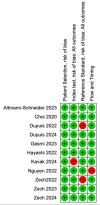Artificial Intelligence in Paediatric and Adolescent Fracture Detection: A Systematic Review and Meta-Analysis
- PMID: 41089155
- PMCID: PMC12516640
- DOI: 10.7759/cureus.92199
Artificial Intelligence in Paediatric and Adolescent Fracture Detection: A Systematic Review and Meta-Analysis
Abstract
Fractures are among the most common injuries in children, yet their radiographic detection is challenging due to the unique anatomy of the developing skeleton, leading to significant diagnostic errors. To address this, a systematic review and meta-analysis was conducted to evaluate how accurately and efficiently artificial intelligence (AI) detects fractures in children and adolescents. Following PRISMA (Preferred Reporting Items for Systematic Reviews and Meta-Analyses) guidelines, a systematic search of PubMed, EMBASE, and Web of Science identified 11 studies published between 2019 and 2024 evaluating AI for detecting appendicular skeletal fractures in patients under 21 years. A meta-analysis revealed that standalone AI demonstrated a statistically significantly higher sensitivity compared to human interpretation (mean difference: 0.04, 95% CI [0.02, 0.07], p = 0.0005) with non-inferior specificity. Furthermore, AI-assisted diagnosis led to a statistically significant improvement in clinician sensitivity (mean difference: 0.07, p = 0.003). To sum up, AI exhibits high diagnostic performance for paediatric fractures and serves as a promising adjunct tool to enhance clinical efficiency and accuracy; however, further large-scale, multi-centre prospective trials are required to validate its real-world applicability and address current limitations before widespread adoption.
Keywords: artificial intelligence; diagnostic accuracy; fracture; fracture detection; imaging; meta-analysis; paediatric; systematic review.
Copyright © 2025, Calleja et al.
Conflict of interest statement
Conflicts of interest: In compliance with the ICMJE uniform disclosure form, all authors declare the following: Payment/services info: All authors have declared that no financial support was received from any organization for the submitted work. Financial relationships: All authors have declared that they have no financial relationships at present or within the previous three years with any organizations that might have an interest in the submitted work. Other relationships: All authors have declared that there are no other relationships or activities that could appear to have influenced the submitted work.
Figures








References
-
- National trends and cost of litigation in UK National Health Service (NHS): a specialty-specific analysis from the past decade. Lane J, Bhome R, Somani B. Scott Med J. 2021;66:168–174. - PubMed
-
- Artificial intelligence technologies to help detect fractures on X-rays in urgent care: early value assessment. [ Jan; 2025 ]. 2025. https://www.nice.org.uk/guidance/hte20 https://www.nice.org.uk/guidance/hte20
-
- Robotic arm-assisted total knee arthroplasty is associated with improved surgical and postoperative outcomes compared with imageless computer navigation: a large single-centre study. Tay ML, Kawaguchi K, Bolam SM, Bayan A, Young SW. Bone Joint J. 2025;107-B:804–812. - PubMed
Publication types
LinkOut - more resources
Full Text Sources
